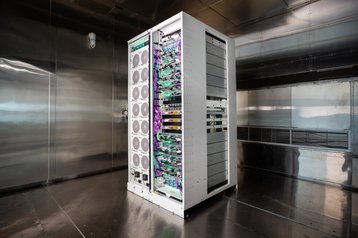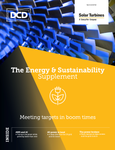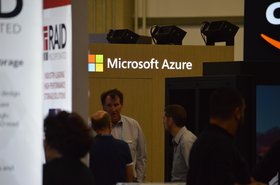In the great rush for land, power, and chips that has marked the artificial intelligence age, none have spent more or deployed more than Microsoft.
“I don't think any industry has gone through what we're going through right now,” Noelle Walsh, the head of the company’s Cloud Operations + Innovation (CO+I) division, tells DCD in a wide-ranging discussion about the company’s approach to the current moment.
This feature appeared in Issue 53 of the DCD Magazine. Read it for free today.
The uncomfortable truth
We’re talking days after Microsoft’s own sustainability report admitted an uncomfortable truth: The rush to deploy large AI clusters has come at a cost, with emissions increasing alongside the expanded deployments.
Overall Scope 1-3 emissions were up 29 percent from 2020, with increased data center construction blamed for the majority of the jump.
“All our sustainability goals are the same,” Walsh counters. “They’ve not gone out of the window: Achieving 100 percent renewable PPAs by 2025, and then at the grid level 24/7 by 2030.”
As for power, Walsh believes that those renewable goals will still be met - “we were always planning to overshoot, and now I just have to plan to overshoot again.”
Traditional renewable PPAs from wind, solar, and hydro will form much of that, but Walsh hopes that another power source could help green its operations.
“The wind doesn't always blow and the sun doesn't always shine - and batteries aren't there yet,” she says. “In the US, we're pushing for more nuclear. There’s some apprehension from the utility to go there, but it would be great.”
Earlier this year, DCD exclusively reported that Microsoft had hired several nuclear experts to head a new division to investigate the technology’s potential in powering data centers.
"[We hired them] to evaluate," Walsh says. "So some of the nuclear power companies are going to shut down their nuclear power plants, and now they're going: ‘Wow, we can retrofit them and make them brand new and continue to operate.' And when we make guarantees and offtakes, it can help them get better loans, etc."
That would mean the company helping traditional nuclear power plants remain operational. Earlier this year, the 800MW Palisades plant announced that it would reopen thanks to a $1.5 billion loan from the Department of Energy - it is not known if it has any anchor tenants.
Rival Amazon Web Services spent $650m this March to acquire a data center at a nuclear power station in Pennsylvania, which it plans to expand into a 15-building campus.
"And then the [Small Modular Reactors (SMRs)] are very interesting and attractive in the US," Walsh continues. "We are working with different technology providers, and then different equipment providers and the utility grid.
"The first one will be expensive. We will invest on the first and then assume there'll be productivity gains. If we invest up front, let us ride the wave."
Walsh says that Microsoft has "not yet struck those deals yet," but is "working with a number of players." Likely at the front is Oklo, an SMR that has signed PPA deals with Equinix and Wyoming Hyperscale. It also happens to be backed by Sam Altman, of Microsoft-funded OpenAI fame.
More 'blue sky' is fusion power, with Microsoft signing a PPA with Helion Energy (also backed by Altman) for 2028. "I've been in a fusion lab," Walsh says. "Plasma at a million degrees, traveling a million miles, and generates net more energy than you need to put into it... the physics works, so I think it'll come through some time."
The investment in power generation is partially one of climate commitments, but also one of sheer necessity - the number of places that potential gigawatt campuses can exist in the US or globally is painfully small.
"The question is, do we need to do more behind the meter? I would rather put it on the grid. But those are the discussions," says Walsh.
Where possible, the company will "move to the power and bring the fiber in, if we're going big."
The drive for AI
Training clusters are growing ever larger, consuming ever more power - but don't, necessarily, need that low latency. "With commercial cloud, we will be more city-based for the proximity to banks, customers, etc. [Training] does give me more of an opportunity to go outside the big cities."
America's rural expanses could see more enormous data centers sprout up to train ever-larger models. But just how large could they grow?
"I ask myself the same question," Walsh says. "The more compute, the more capability these models have. I'm looking at it from an infrastructure perspective - you would be stunned at what we are working on and what is possible.”
She won't comment on Stargate, a rumored $100bn, 5GW mega data center for OpenAI - although other Microsoft employees have downplayed the story.
"For me, it's great not to have to build 100 small things if I can build 20 big ones," Walsh says, sidestepping the matter. "We get economies of scale and efficiency if you go to the right places, and you set up right."
She goes back to the value of bringing (a few) jobs to rural communities through large AI clusters. "The first ChatGPT was trained at a supercomputer built in Iowa. ChatGPT: It's not made in California. It's made in Iowa."
The distinction between AI training data centers and commercial cloud is a challenging one, requiring Microsoft and the wider industry to go out on a limb building an entirely new type of facility in non-traditional locations on behalf of a speculative and changing technology that has yet to prove it can underpin sustainable business models.
“It's a massive investment, billions of dollars of investment,” Walsh says. “We can't all go wild, ‘cause you're talking country GDP-type of investments. But we can't miss the wave.”
Where possible, the company is looking at whether the training data centers can be used for inferencing in the future, or could be “converted to commercial cloud in the future,” but if it “had to always have that fungibility, we wouldn't grow fast enough.”
She adds: “But we do aim to strike that balance.”
Finding the right approach comes at a time of extreme crunch, where demand to deploy has never been tougher. “First there was Covid and then it was the Ukraine war,” she says. “Now I've accepted there is no going back. We talk about 'Today is another week,' that's what it feels like.”
That pressure could help lead to positive changes, Walsh hopes. “I'd like to think maybe the urgency now will encourage innovation and change.
“The way I look at it, we want to evolve society through AI. So we're not going to do that by taking a step back in sustainability. I think there’s the opportunity to shift it the other way.”








